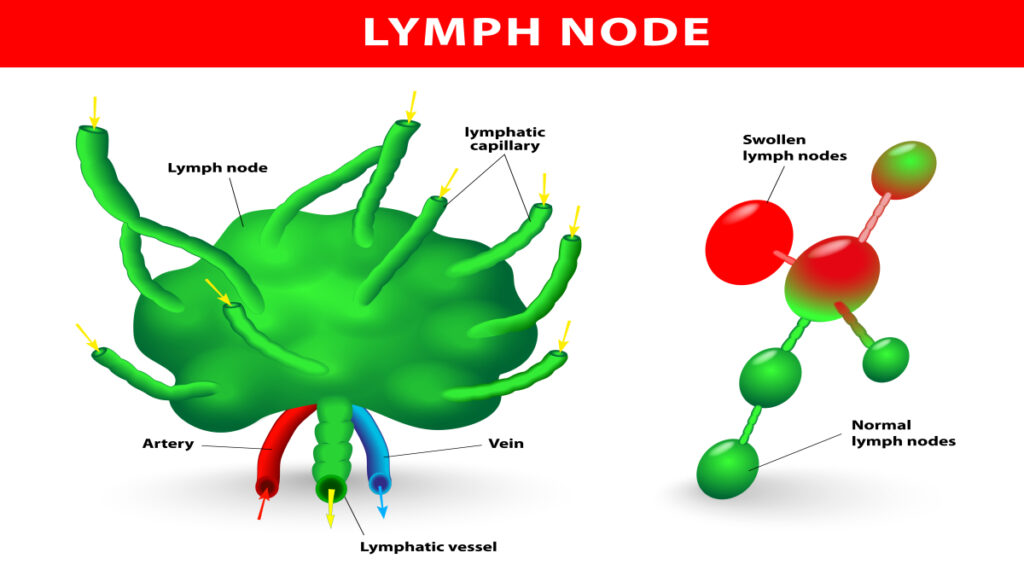
Overview
Swollen lymph nodes, also called lymphadenopathy or lymphadenitis, occur due to an infection caused by bacteria, viruses, or fungi. Viral infections, such as the common cold, are the most common causes of swollen lymph nodes.
Lymphadenopathy is more noticeable behind the ear, under the chin, in the neck, in the armpits, and in the groin.
Lymph nodes are small, bean-shaped structures found throughout the body and near the lymphatic vessels. They contain immune system cells, such as lymphocytes and macrophages, which are essential in immunologic functions. Furthermore, they filter the clear fluid which passes through the lymphatic system (lymph) and selectively remove and destroy foreign organisms.
These lymph nodes become swollen during immune reactions that involve the lymphatic system. During these reactions, invading organisms are destroyed by the lymph nodes to prevent infection and illness.
Key Facts
- Lymph nodes can be found throughout the body but can be felt (palpated) only when they become enlarged.
- Lymphadenopathy is seldom caused by cancer. The most common cause is a viral infection.
- Enlarged lymph nodes on the side of the neck and under the jaw are very common and may indicate infections such as upper respiratory infections or tooth infections.
- The enlargement of lymph nodes may not necessarily indicate infection or an underlying condition. Visible lymph nodes under the chin or the groin may be found in healthy children and young adults.
- Treatment depends on the cause of the swelling. Some swollen lymph nodes return to normal when the underlying disease is treated.
- Untreated lymphadenitis caused by infection can form an abscess (a collection of pus in an area).
Symptoms and Diagnosis
Symptoms
Symptoms usually depend on the cause of inflammation (swelling). The swollen nodes may be the size of a pea or kidney bean and may be tender (painful) when touched.
Other symptoms which may be present include:
- Runny nose
- Sore throat
- Fever
- Cough
- Chills
A runny nose, sore throat, and fever may be an indication of an upper respiratory tract infection.
Symptoms of more serious medical conditions that cause swollen lymph nodes are:
- Night sweats
- Weight loss
- High-grade fever
- Red skin over lymph nodes
- Abdominal pain
- Swelling of multiple lymph nodes throughout the body may indicate HIV infection or rheumatoid arthritis (a chronic inflammatory disease of joint tissue).
- Hard masses are found under the skin closer to the swollen lymph nodes.
Enlarged lymph nodes above the collarbone may suggest lung cancer or a lung infection.
Hard, fixed nodes that rapidly increase in size may indicate a malignant tumour in the lymph nodes (lymphoma) or cancer. Meanwhile, soft, painful, and mobile lymph nodes may represent an infection.
The complication of swollen lymph nodes
When a lymph node swelling related to infection is left untreated, an abscess which is a pus-filled cavity may form. The skin around the enlarged lymph node may also become infected.
Diagnosis
To recognize the cause of lymphadenitis, doctors may employ:
- Medical history: The doctor may ask about the onset and duration of the swelling and the associated symptoms. They will inquire about previous illnesses or injuries and the intake of certain medications which are known to trigger this condition.
- Physical examination: The physician feels the lymph nodes beneath the affected area’s skin for size, tenderness (pain), and texture. They may also examine the skin around the area for red patches or any other discolouration.
- Blood test: This test may be used to confirm lymphadenopathy or rule out other suspected underlying conditions. Routine blood test detects signs of infection responsible for the swelling.
- Imaging studies: X-rays, CT scans, and ultrasounds are used to evaluate the lymph nodes or the affected areas to determine the cause of infection and check for tumours that may be cancerous.
- Lymph node biopsy: In this procedure, a part of the lymph node or the entire lymph node is removed using a thin needle-like tool and sent to the laboratory for examination under the microscope. Diseases, such as cancer, can be diagnosed or ruled out.
Causes and Prevention
Causes
The most common cause of lymphadenitis is an infection, especially a viral infection. Lymph nodes increase in size when an infection occurs in or around the area where they are found.
Some infections which may cause swollen lymph nodes include:
- Ear infection
- Measles
- Chickenpox
- Common cold
- Sinus infection
- HIV infection
- Strep throat (an infection of the throat).
- Tooth infection
- Skin infection
Other uncommon infections include:
- Tuberculosis
- Tonsillitis (inflammation of the tonsils)
- Sexually transmitted infections such as gonorrhoea and syphilis.
- Shingles (herpes zoster)
- Toxoplasmosis (a parasitic disease)
Non-infectious causes of swollen lymph nodes include:
- Immune system disorders like lupus (a chronic inflammatory disease of the joints, kidneys, blood cells, heart, and lungs) and rheumatoid arthritis (inflammation of the tissue of joints).
- Cancer: Cancer of the lymphatic system (lymphoma) and cancer of white blood cells (leukaemia).
- Stress
- Mouth sores
- Certain medications (anti-seizure and antimalarial drugs).
Prevention
The only way to prevent swollen lymph nodes is to avoid what can actually cause inflammation of the lymph nodes, particularly common infections by viruses.
Some preventive measures include:
- Proper hand washing
- Use of disinfectant on surfaces
- Proper dental hygiene ensures healthy teeth and gums
- Vaccination against shingles, tuberculosis, and flu.
- Healthy eating habits, regular exercise, and good rest.
- Proper use of prescribed medication, and replacing drugs that trigger allergic reactions according to your doctor’s advice.
Typical Treatments
Enlarged lymph nodes may become smaller without treatment. Lymphadenopathy caused by viral infection disappears when the infection resolves.
According to the Mayo Clinic, treatment for swollen lymph nodes usually depends on the cause.
Infection: Antiviral medications or antibiotics may be used to eliminate the cause of infection. Acetaminophen and ibuprofen are used to reduce pain and decrease swelling.
Cancer: Swollen lymph nodes caused by cancer may not return to normal until the cancer is treated. Radiation or chemotherapy may be used to shrink or destroy cancer cells. In addition, surgery can be performed to remove tumours.
Conclusion
Swollen lymph nodes also called lymphadenopathy, result from the body’s reaction to foreign organisms, which can cause illness or infection. They indicate the effectiveness of the immune system against bacteria or viruses.
The causes may be bacterial and viral infections or other related disease conditions. Meanwhile, the symptoms are usually a pointer to the underlying conditions responsible for the swelling.
Most swollen lymph nodes become normal as the infection resolves, while others may be a sign of severe underlying conditions like cancer.
MOST COMMON






